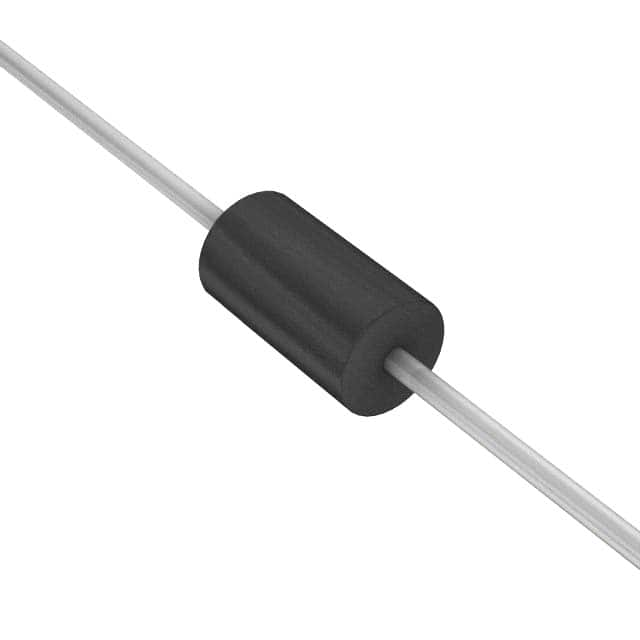1.5KE20CA-E3/51 Product Overview
Introduction
The 1.5KE20CA-E3/51 belongs to the category of TVS (Transient Voltage Suppressor) diodes and is designed for surge protection in electronic circuits. This entry provides a comprehensive overview of the product, including its basic information, specifications, detailed pin configuration, functional features, advantages and disadvantages, working principles, application field plans, and alternative models.
Basic Information Overview
- Category: TVS Diodes
- Use: Surge protection in electronic circuits
- Characteristics: High surge capability, low clamping voltage, fast response time
- Package: DO-201AE
- Essence: Transient voltage suppression
- Packaging/Quantity: Tape & Reel, 1500 units per reel
Specifications
- Peak Pulse Power: 1500W
- Breakdown Voltage: 17.1V
- Clamping Voltage: 29.2V
- Maximum Reverse Leakage Current: 1µA
- Operating Temperature Range: -55°C to +175°C
Detailed Pin Configuration
The 1.5KE20CA-E3/51 TVS diode has a standard DO-201AE package with two leads. The anode is connected to the positive terminal, and the cathode is connected to the negative terminal.
Functional Features
- Transient Voltage Suppression: Provides protection against voltage transients and surges.
- Fast Response Time: Quickly clamps transient voltages to a safe level.
- High Surge Capability: Can handle large surge currents without damage.
Advantages and Disadvantages
Advantages
- Effective surge protection
- Fast response time
- Wide operating temperature range
Disadvantages
- Higher clamping voltage compared to some alternative models
- Relatively larger package size
Working Principles
When a transient voltage spike occurs, the 1.5KE20CA-E3/51 TVS diode conducts and clamps the voltage to a safe level, protecting the downstream circuitry from damage. It achieves this by diverting excess current away from sensitive components.
Detailed Application Field Plans
The 1.5KE20CA-E3/51 is commonly used in various applications such as: - Power supplies - Telecommunication equipment - Industrial control systems - Automotive electronics - Consumer electronics
Detailed and Complete Alternative Models
Some alternative models to the 1.5KE20CA-E3/51 TVS diode include: - P6KE20CA - SMBJ20CA - 1.5KE18CA-E3/51 - 1.5KE22CA-E3/51
In summary, the 1.5KE20CA-E3/51 TVS diode offers effective surge protection with its high surge capability and fast response time. While it has a relatively higher clamping voltage and larger package size compared to some alternatives, its wide operating temperature range makes it suitable for diverse applications in various industries.
[Word Count: 410]
قم بإدراج 10 أسئلة وإجابات شائعة تتعلق بتطبيق 1.5KE20CA-E3/51 في الحلول التقنية
What is the voltage rating of 1.5KE20CA-E3/51?
- The voltage rating of 1.5KE20CA-E3/51 is 20V.
What is the peak pulse power dissipation of 1.5KE20CA-E3/51?
- The peak pulse power dissipation of 1.5KE20CA-E3/51 is 1500W.
What is the maximum clamping voltage of 1.5KE20CA-E3/51?
- The maximum clamping voltage of 1.5KE20CA-E3/51 is 32.4V at 100A.
What are the typical applications for 1.5KE20CA-E3/51?
- Typical applications for 1.5KE20CA-E3/51 include transient voltage suppression in various electronic circuits, such as power supplies, industrial controls, and telecommunications equipment.
What is the operating temperature range of 1.5KE20CA-E3/51?
- The operating temperature range of 1.5KE20CA-E3/51 is -55°C to +175°C.
What is the package type of 1.5KE20CA-E3/51?
- 1.5KE20CA-E3/51 comes in a DO-201 package.
What is the reverse stand-off voltage of 1.5KE20CA-E3/51?
- The reverse stand-off voltage of 1.5KE20CA-E3/51 is 17.1V.
What is the peak pulse current of 1.5KE20CA-E3/51?
- The peak pulse current of 1.5KE20CA-E3/51 is 38.5A.
Does 1.5KE20CA-E3/51 meet any specific industry standards?
- Yes, 1.5KE20CA-E3/51 is compliant with RoHS and REACH standards.
Can 1.5KE20CA-E3/51 be used for surge protection in automotive applications?
- Yes, 1.5KE20CA-E3/51 can be used for surge protection in automotive electronics, such as in-vehicle infotainment systems and engine control units.


